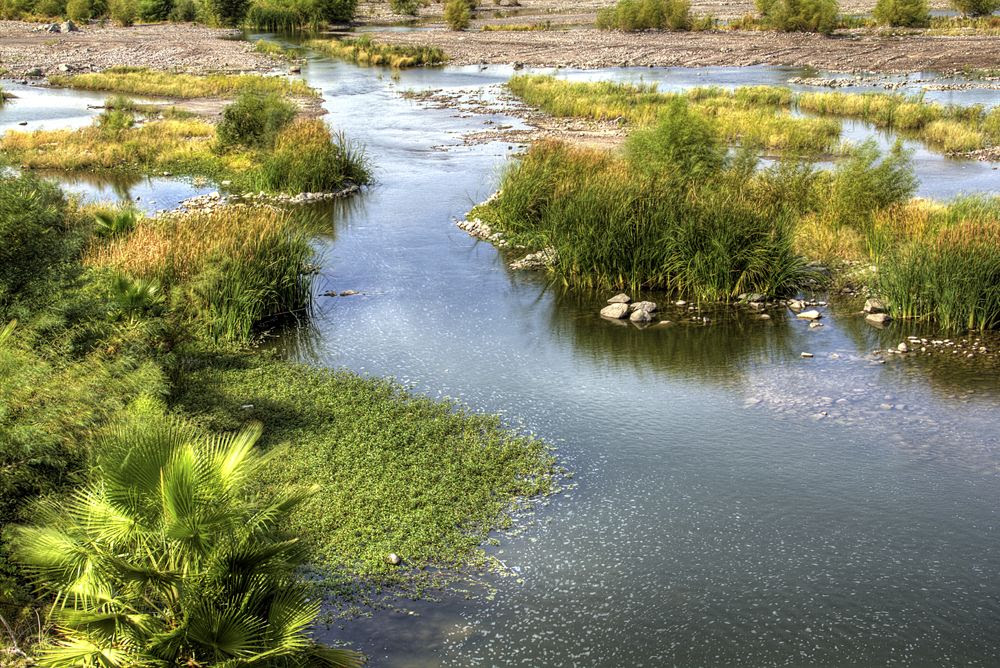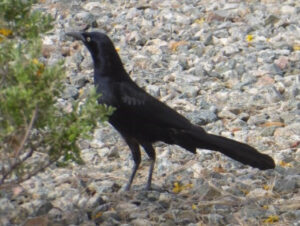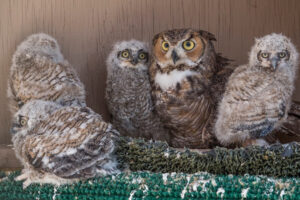Discrete Places to Find Interesting Things
by Corinne Johnson
Liberty Wildlife Intern
Abandoned pits. Busy lakes. Empty fields. Everyone at some point during their time in the valley has seen these around Phoenix and thought that there was nothing interesting to see. But not everything is as it appears on the surface.
Behind Ewing’s Irrigation on Harbor Dr. there is a borrow pit that was inadvertently transformed into a small wetland. Borrow pits are excavated areas often found at construction sites that have been dug for materials to use elsewhere. Dug in the 1980s, this borrow pit was initially used for materials to build up the levee surrounding the Salt River until they dug into the water table. Once they ceased construction in the pit, life started to appear. The water immediately attracted mallards and American coots. Mesquite, cattails, and other reeds grew in the pit. Fish were introduced enticing great blue herons, great egrets, and osprey. An unexpected wetland ecosystem started to flourish in the most unexpected of places.
Tempe Town Lake started as an architecture class project at ASU to capture the Salt River and convert the river bed from a dumping ground into an iconic attraction. Under the McClintock bridge, a wetland prospers and Neotropic cormorants, white pelicans, osprey, and waterfowl all frequent the lake. While the architects never intended for the lake to become a hotspot for wildlife, try walking the trails around the park and in Indian Bend Wash to see everything this riparian area has to offer.

On the corner of Baseline Rd. and 32st street, there are many barren fields. At first glance, there is nothing remarkable to see yet, once you understand the history of the land, it becomes extraordinary. These plots of land were historically used as farmland due to the unique microclimate caused by South Mountain, but these plots were not ordinary farms. They were cultivated by Japanese Americans post-WWII as flower farms and became a staple of South Phoenix until the early 2000s. Now mesquites, Palo Verdes, eucalyptus, and sissoo trees thrive. Quail, Abert’s towhees, and Anna’s hummingbirds zip around the fields. These plots of land no longer serve as flower farms, but once you stop and look around you can see it is still teeming with life.
These landscapes have unique histories and embody more life than they are given credit for. We are told to not judge a book by its cover and we should apply this same school of thought to novel ecosystems. There is always more to see than just an abandoned pit, a touristy lake, or an empty field.
Keys to Survival
by Gail Cochrane
Liberty Wildlife Volunteer
Popular belief holds that baby birds shed their fluffy down, spread newly feathered wings and launch into the skies, never to look back. In fact, many species of fledglings stay on near the nest while their parents provide meals and model foraging or hunting behaviors.
Fledgling red-tailed hawks remain in the nesting area for about three weeks, devouring prey delivered to them by their parents. Gradually the youngsters learn to make their own kills. Juveniles band together in small groups until individuals finally disperse in the fall.
For a month or more, young grackles follow their mother from tree to tree, begging loudly and learning from her what’s out there to eat. Eventually, she refuses to share, forcing her youngsters to strike out on their own.

Raven youngsters are eager to leave the nest but slow to learn to fly. Fledglings practice the use of their flight apparatus and receive hand-outs from mom and dad for several weeks. Then the whole family leaves the nest area together. Omnivores such as ravens eat a wide variety of foods so these youngsters need to discover many sources of nutrition. According to raven expert Bernd Heinrich, there is a critical stage in a fledgling’s development when it learns from its parents about edible items and what to avoid. After the imprint period ends, ravens become naturally suspicious of anything new. In late summer young ravens join up with other juveniles while they continue to study Survival 101. Among ravens, it generally falls to the lowest on the totem pole (the omega bird) to venture out to inspect a new discovery. The others watch and wait to find out if this strange item is edible or hazardous.
Great horned owls are among the slowest to mature. About six weeks after hatching the owlets begin to branch, hopping to nearby perches and ledges. They learn to fly over the next month, a process that’s not always pretty. But it takes the youngsters another three to four months to learn to kill their own food. LW Animal Care Coordinator Jan Miller believes that great horned owls are more instinct-driven than birds such as ravens so known for their intelligence. She suggests the instinct to kill for food is awakened in youngsters of a certain age when they observe adults hunting. At Liberty Wildlife, orphan owl nestlings are raised in mews by foster parents and moved to flight cages when their feathers come in. To prepare for their release, adult great horned owl fosters demonstrate predatory skills as they kill live mice let loose in the flight cages.

Barn owls and screech owls hang on with their parents for up to two months after leaving the nest. Condor young stay attached for so long that the adults only breed every other year. The length of time spent with parents after learning to fly demonstrates the magnitude of skills a bird needs to survive its first hazardous year of life.
Often, birds that leave their parent’s care the earliest move immediately into flocks or small groups of juveniles. Finches and doves disperse from nesting areas within a week or two after fledging. Among the flock, they learn the skills they need to survive.
It’s a Mystery to me!
by Claudia Kirscher
Liberty Wildlife Volunteer
[This article was originally published in the June 2012 edition of Nature News]
The origin of common bird names can be an endless source of speculation. The research is just plain fascinating, along with a good chuckle or two about “What were they thinking!?”. Some bird names were created by colonial immigrants from England, with linguistic roots that come from English bird names, Native American, Spanish, Portuguese, French-Canadian, and Latin. Many have been named for their calls/songs, behaviors, specific habitat or color, while others are named for an individual person. Some seem to fall into the mystery or ‘no sense’ category. Let’s go exploring!
Phainopepla (pronounced fay-no-Pep-la)- Greek for “shining robe”, referring to the shiny black plumage of the males. This bird is often referred to as the black cardinal.
Northern Cardinal – named for the cardinals of the Roman Catholic Church, who wear distinctive red robes and caps.
Dodo Bird (now extinct) – named for the Portuguese word doudo meaning foolish person (because of the bird’s trusting and unafraid nature).
Eagle – The modern English name of the bird is derived from the Latin term aquila by way of the French aigle. The Latin aquila may derive from the word aquilus, meaning dark-colored, swarthy, or blackish, as a description of the eagle’s plumage.
Cormorant – comes via the old French cormaran from medieval Latin corvus marinus, meaning sea-raven.
Merganser – A diving goose, from mergere, to dive and anser, a goose.
Peregrine – the wanderer from abroad, the foreigner – originally the person or animal who has traveled “per agrum” – through the fields.
Avocet– French avocette, Italian avocetta, meaning literally “graceful bird”.
Vulture – Middle English vulture, vultur, voltur, Anglo-Norman vultur, Old French voultour, Latin vulturius, vultur, meaning a “tearer”.
Pelican – Old English pellican, pellicane, Latin pelicanus, Greek pelekan or pelekus, meaning “axe”, reflecting the bird’s bill shape.
Oriole – clearly linked to Latin aureus, or golden. The Baltimore Oriole sports the colors of one Lord Baltimore.
Canary – named after the Canary Islands, so-called because in olden times, one of the islands was noted for breeding large dogs (canis in Latin).
Harris’s Hawk – named by John J. Audobon for his friend and financial supporter, Edward Harris.
Loon – from a Scandanavian word lom, meaning “clumsy” because these birds are built for swimming but are very awkward on land.
Grosbeak – from the French word grosbec, which means “large beak”.
Some names come from the noises birds make, such as the pipit, hoopoe, kittiwake, cuckoo, and chickadee (although imagination may be required to recognize some of these names in the sound).
Others are named for their behavior or habitat: burrowing owl, thrasher (stirring up the ground looking for insects), American dipper (constant body dipping into streams), wood duck (nest in tree cavities), and juniper titmouse.
Flicker – may be named for its motion flying from tree to tree, showing white wing spots, which present a flickering effect.
Sometimes color says it all: vermillion flycatcher, yellow warbler, and mountain bluebird.
A few names are more mysterious or just don’t figure. The red-bellied woodpecker of the eastern U.S. has a red head or nape and only a pinkish wash to the belly. The nighthawk is not a hawk at all, and is most common at dusk.
Sources: Cornell Lab, Sibley guides, Webster’s Dictionary, Wikipedia, Birds of Britain, and various internet sites.
Kid Stuff
Nurturing Nature
by Carol Suits
Liberty Wildlife Volunteer
Can you make an important difference in the lives of living things? YES! It doesn’t matter who you are or where you live, you can help nurture nature. This month, Kid Stuff has a poster* with information, crafts, links to activities and projects you might like. See you next month for a new poster!

*National Wildlife Federation/Ranger Rick publication
Meet Madhvi! She’s calls herself the “No Styrofoam Ninja”! She’s been working since she was about 7 years old to ban Styrofoam everywhere.
https://www.madhvi4ee.com/
Bats, birds, and some owls might need a home. Go online with a parent and look at these two suggestions then search for more ideas.
https://www.batcon.org/about-
http://www.nabluebirdsociety.
You can help save endangered species. Which ones live near you? Go to this website and enter your state to find out. https://www.fws.gov/
This is a cool project you can do to make your backyard or schoolyard an official wildlife habitat. Go with an adult to this site: https://nwf.org/certify
Puzzle Fun!
https://www.jigsawplanet.com/?
https://www.jigsawplanet.com/?
https://www.jigsawplanet.com/?



